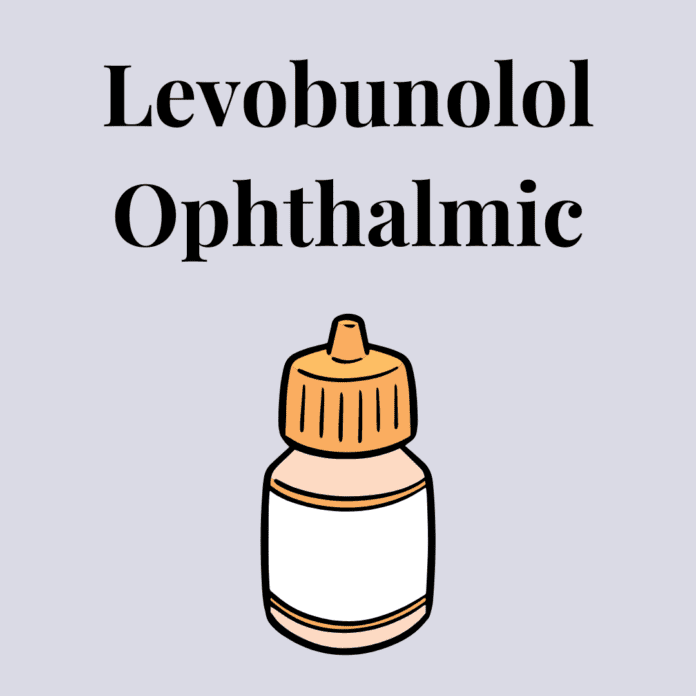Uses of Levobunolol Ophthalmic
Ophthalmic levobunolol is used to treat glaucoma, a condition in which increased pressure in the eye can lead to a gradual loss of vision. Levobunolol is in a class of medications called beta-blockers. It works by decreasing the pressure in the eye.
Side Effects of Levobunolol Ophthalmic
Levobunolol ophthalmic may cause side effects. Tell your doctor if any of these symptoms are severe or do not go away:
- eye stinging or burning
- discomfort, redness, or itching of the eye
- swelling of the eyelids
- decreased vision
Some side effects may be serious. If you experience any of the following symptoms, stop using the eye drops and call your doctor immediately:
- difficulty breathing
- wheezing
- slow or irregular heartbeat
- faintness
- swelling of the feet and legs
- sudden weight gain
Warnings & Precautions
Before using levobunolol ophthalmic:
- tell your doctor and pharmacist if you are allergic to levobunolol, other beta blockers, sulfites, or any other drugs.
- tell your doctor and pharmacist what prescription and nonprescription medications you are taking, especially other eye medications, beta blockers, such as atenolol (Tenormin), carteolol (Cartrol), labetalol (Normodyne, Trandate), metoprolol (Lopressor), nadolol (Corgard), propranolol (Inderal), sotalol (Betapace), or timolol (Blocadren); quinidine (Quinidex, Quinaglute Dura-Tabs); verapamil (Calan, Isoptin); and vitamins.
- tell your doctor if you have or have ever had thyroid, heart, or lung disease; congestive heart failure; or diabetes.
- tell your doctor if you are pregnant, plan to become pregnant, or are breast-feeding. If you become pregnant while using levobunolol ophthalmic, call your doctor.
- if you are having surgery, including dental surgery, tell the doctor or dentist that you are using levobunolol eye drops.
- if you are using another topical eye medication, instill it at least 10 minutes before or after you instill levobunolol ophthalmic.
Dosage
Ophthalmic levobunolol comes as a solution (liquid) to instill in the eyes. Levobunolol eye drops are usually instilled once or twice a day. Follow the directions on your prescription label carefully, and ask your doctor or pharmacist to explain any part you do not understand. Use levobunolol eye drops exactly as directed. Do not use more or less of them or use them more often than prescribed by your doctor.
Levobunolol eye drops to control glaucoma but does not cure it. Continue to use levobunolol eye drops even if you feel well. Do not stop using levobunolol eye drops without talking to your doctor.
To instill the levobunolol ophthalmic, follow these steps:
- Wash your hands thoroughly with soap and water.
- Check the dropper tip to make sure that it is not chipped or cracked.
- Avoid touching the dropper tip against your eye or anything else; eye drops and droppers must be kept clean.
- While tilting your head back, pull down the lower lid of your eye with your index finger to form a pocket.
- Hold the dropper (tip down) with the other hand, as close to the eye as possible without touching it.
- Brace the remaining fingers of that hand against your face.
- While looking up, gently squeeze the dropper so that a single drop of levobunolol ophthalmic falls into the pocket made by the lower eyelid. Remove your index finger from the lower eyelid.
- Close your eye for 2 to 3 minutes and tip your head down as though looking at the floor. Try not to blink or squeeze your eyelids.
- Place a finger on the tear duct and apply gentle pressure.
- Wipe any excess levobunolol ophthalmic from your face with a tissue.
- If you are to use more than one drop in the same eye, wait at least 5 minutes before instilling the next drop.
- Replace and tighten the cap on the dropper bottle. Do not wipe or rinse the dropper tip.
Wash your hands to remove any medication.
Other
Keep all appointments with your doctor. Your doctor will order certain eye tests to check your response to levobunolol ophthalmic.
Do not let anyone else use your medication. Ask your pharmacist any questions you have about refilling your prescription.
It is important for you to keep a written list of all of the prescription and nonprescription (over-the-counter) medicines you are taking, as well as any products such as vitamins, minerals, or other dietary supplements. You should bring this list with you each time you visit a doctor or if you are admitted to a hospital. It is also important information to carry with you in case of emergencies.
Source
All information has been provided courtesy of MedLinePlus from the National Library of Medicine and from the FDA.



